I wish I’d been there the day kebabs were invented. I picture a group of Neanderthals holding chunks of mammoth in their fists over an open flame, sweating and hopping up and down in pain, fingers blistering. And then they turn and see Gorg calmly roasting his dinner arm’s length from the fire, meat neatly skewered onto a long pointy stick.
Kebab technology has come a long way through the millennia — according to some historians, the cooking technique was pioneered by medieval Turkish soldiers who used swords as campfire skewers. (Not exactly swords into plowshares, but at least a step in the right direction.)
Kebabs accompanied the spread of the Ottoman Empire, showing up in the cuisines of the Middle East and Mediterranean regions, and from there around the world.
And no wonder — food on a stick is convenient, efficient, and fun. Done over a campfire, it allows people to socialize while their dinner cooks and requires minimal preparation.
Cultures around the world have innovated skewered food in ways both savory and sweet. In the Middle East, there are kebabs, both shish and doner. Japanese cuisine features yakitori, while in China there’s sweet tanghulu. India has tikka, Thailand satay, and Russian shashlik. And, of course, American carnivals and state fairs feature corn dogs, fried cheese, and deep-fried candy bars.
Whoa, that got unhealthy fast! Can we turn things around and go in the other direction? Is it possible to make kebabs out of healthy, whole foods? Can we enjoy food on a stick the plant-based way?
Why Choose Vegan Skewers or Kebabs?

There are many reasons to limit or eliminate meat from your diet, including those related to health, the environment, and ethics. If health is a main concern of yours, there’s even more reason to avoid meat that’s grilled or cooked over an open flame at high temperatures.
Better for Your Health
Cooking meat in this way forms AGEs, a very apt acronym for Advanced Glycation End-products that can accelerate aging in your brain and lead to cognitive decline. Open flame high-heat cooking also creates carcinogenic compounds in meat, such as heterocyclic amines (HCAs) and polycyclic aromatic hydrocarbons (PAHs).
Not only do these harmful compounds end up sticking to the outside of the grilled meat, they’re also released into the air — so just hanging around next to the grill at a barbecue can introduce them into your body.
By contrast, grilling fruits and vegetables doesn’t create nearly as much of these compounds. While any food high in fat and protein — including soy foods like tofu and tempeh, as well as highly processed plant-based meat alternatives — will produce some level of AGEs, HCAs, and PAHs when grilled, eating a plant-based diet can reduce AGEs by 79%.
You can reduce your AGEs exposure even further by using oil-free marinades rather than oils to coat plant-based kebab ingredients.
And plant-based diets are healthier in general. Plant-based foods that aren’t highly processed contain fiber, which is severely lacking in industrialized diets (and almost entirely absent from meat).
If you choose whole foods over processed ones, you’re also getting more nutrients per calorie, including antioxidants, vitamins, and minerals.
Plants are much lower than meat in saturated fat, and they don’t contain certain compounds in meat that cause inflammation, such as TMAO and IGF-1.
Better for Animals and the Environment

Eating plants instead of animals is also better for those animals and for the environment. It turns out that animal agriculture is responsible for a surprisingly high amount of the world’s greenhouse gas emissions, as well as being a leading cause of deforestation.
Because converting plant protein to animal protein is so inefficient, huge amounts of land produce animal feed instead of feeding hungry people directly.
Industrial animal agriculture is not only cruel to animals, it’s also pretty cruel to humans. Factory farming contributes to algal blooms, foodborne illness, pandemics, water pollution, and other major health issues.
Replacing animal foods with plant foods is a healthier and environmentally friendly choice. And fortunately, there are many ways to get creative with vegan versions of skewer or kebab recipes.
Essential Plant-Based Ingredients for Food on a Stick
So what kinds of plant-based ingredients can go on a stick? Basically, anything you can cut into chunks or pierce whole that won’t fall off.
That includes many vegetables, such as mushrooms, cauliflower, eggplant, bell peppers, onions, cherry or grape tomatoes, and summer squash like zucchini. Onions can be tricky because, as Shrek pointed out, they have layers.
Some fruits do really well in kebabs, especially the firm ones like jackfruit, pineapple, mangoes, grapes, and just-ripe peaches and apricots.
If you want to add more meaty texture and umami flavor to your kebabs, there are plant-based proteins and meat analogues that can range from lightly processed (tempeh, tofu, and bean/lentil burgers) to medium (seitan) to highly processed (plant-based meat alternatives to chicken tenders and meatballs).
For flavoring your food on a stick, consider plant-based marinades, sauces and dips, and herbs and spices.

Preparing Your Skewers
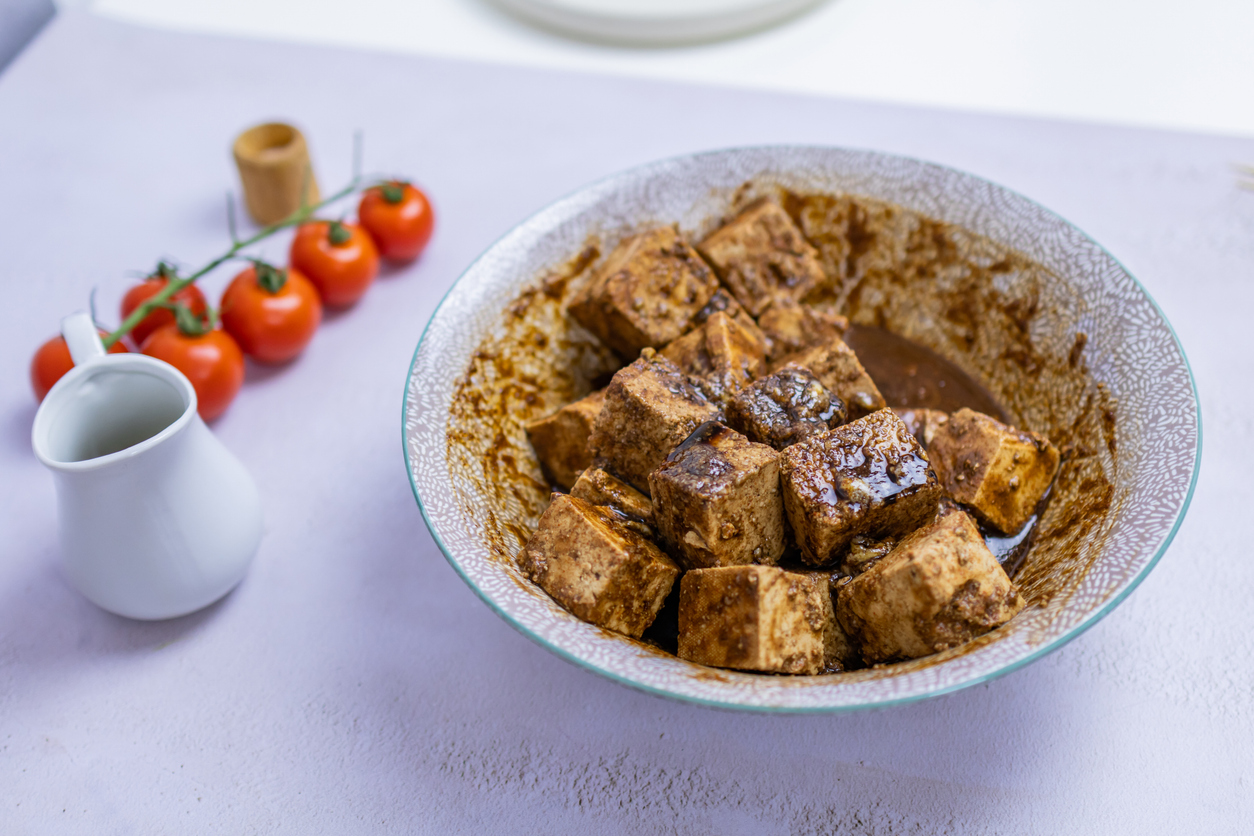
You can use wood or metal skewers to put together your creations. If wood, soak them in water first to keep them from burning.
Next, prepare your marinade (see the recipes below for examples and inspiration).
Then, cut the ingredients into chunks or slices for easy skewering and cooking (except for round whole foods like small tomatoes and cocktail onions). One of the secrets to good kebabs is to have all pieces roughly the same size; that way, you don’t end up with mushy bits of abandoned tomato skin wedged between hard, raw zucchini bites.
Marinate the ingredients to add flavor: 10–15 minutes for softer fruits and vegetables with high water content, and longer (even overnight) for firmer foods.
Here’s a video of someone making classic veggie kebabs in an improbably clean kitchen.
https://www.youtube.com/watch?v=Yflttw_VUZA
One of the nice things about kebabs is that they’re portable, especially before cooking. You can prepare sticks with marinated ingredients and bring them to a barbecue to feed the plant-based eaters (and make the omnivores jealous if you’re not in a sharing mood).
How to Cook Your Kebabs
You’ve got several options for cooking kebabs, including grilling, oven roasting, stovetop cooking, and even skipping the heat and enjoying raw fruits and veggies on a stick.
For grilling, preheat the grill until it reaches medium-high heat. Place the skewers on the grill and cook for about 10–15 minutes, turning them every few minutes to heat evenly. They’re done when tender, heated through, and sporting grill marks.
Oven-roasting vegan skewers begins by preheating the oven to 400°F (200°C). Place the skewers on a baking sheet lined with parchment paper or a silicone mat. Roast for about 20–25 minutes, turning once halfway through, until the vegetables are tender and slightly browned.
You can kebab (I’m declaring that a verb) on a stovetop by heating a grill pan or large skillet over medium-high heat. Add some water or broth (or oil if you use it) to the pan and cook the skewers for about 10–15 minutes, turning occasionally, until the vegetables are tender and slightly crispy on the edges.
After cooking, you can serve your skewers with a dipping sauce.
And as mentioned, you can also make kebabs without cooking, using raw fruits and vegetables. If you’re skipping the heat, other fruits become possible, such as grapes, berries, and citrus fruits like oranges, tangerines, and grapefruit.
Kebab and Skewer Recipes
Get ready to revolutionize your meals with this collection of seven irresistible skewer and kebab recipes! Plant-based foods on a stick can be delicious, easy, and festive, perfect for adding a splash of fun to any occasion.
Whether you’re hosting a backyard barbecue, planning a picnic, or simply looking to make dinner more exciting, these recipes will bring a burst of flavor and creativity to your table. From colorful veggie and fruit combinations to innovative plant-based proteins, these skewers and kebabs are designed to tantalize your taste buds and prove that plant-based eating can be both scrumptious and entertaining!
1. Grilled Watermelon and Pineapple Skewers
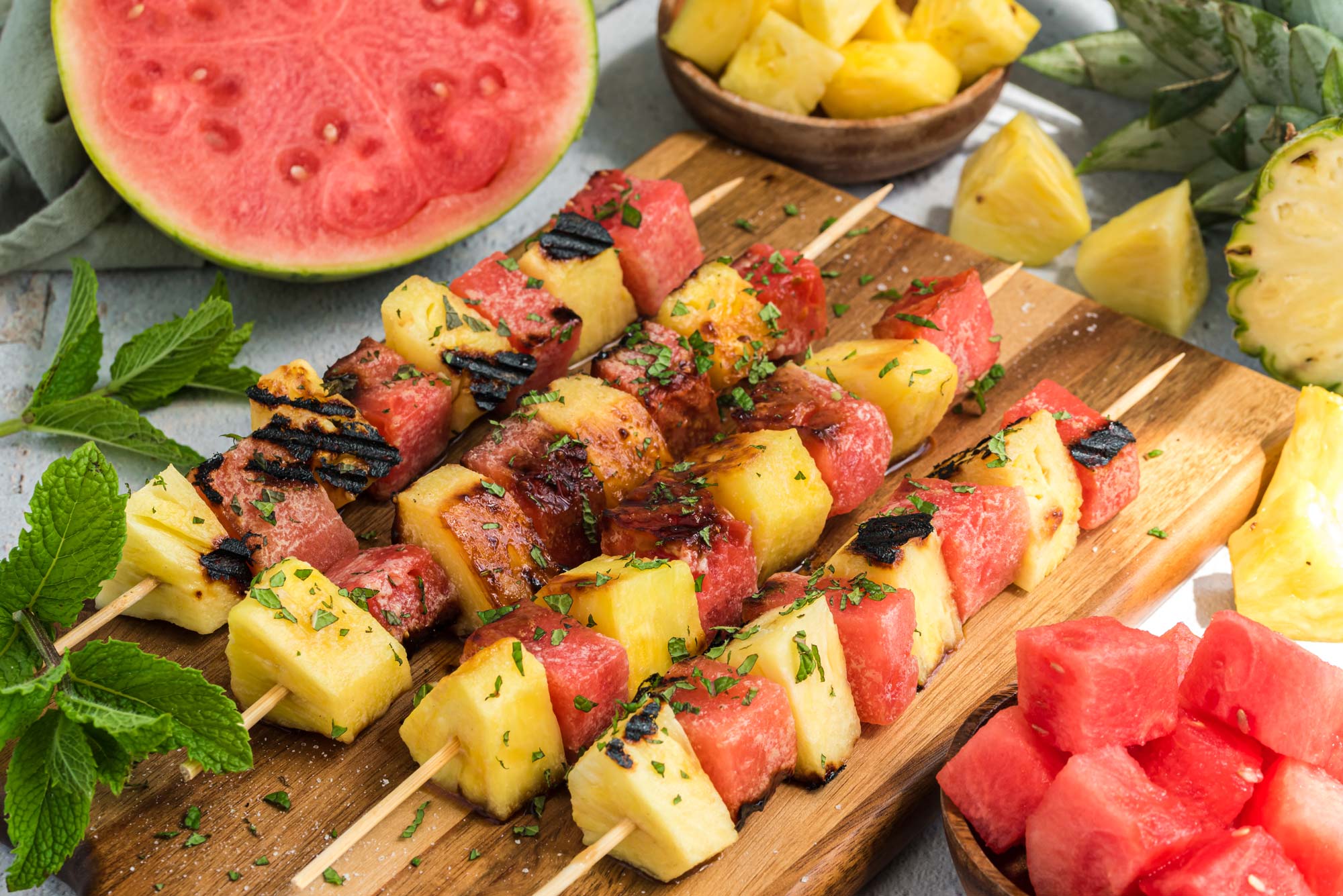
When you grill these two scrumptious fruits together and then drizzle a nutty and zesty tahini lime mixture over top, something magical happens to your taste buds (like, WOW!). Together watermelon and pineapple bring a whole new definition to summertime grilling.
2. Tempeh Satay
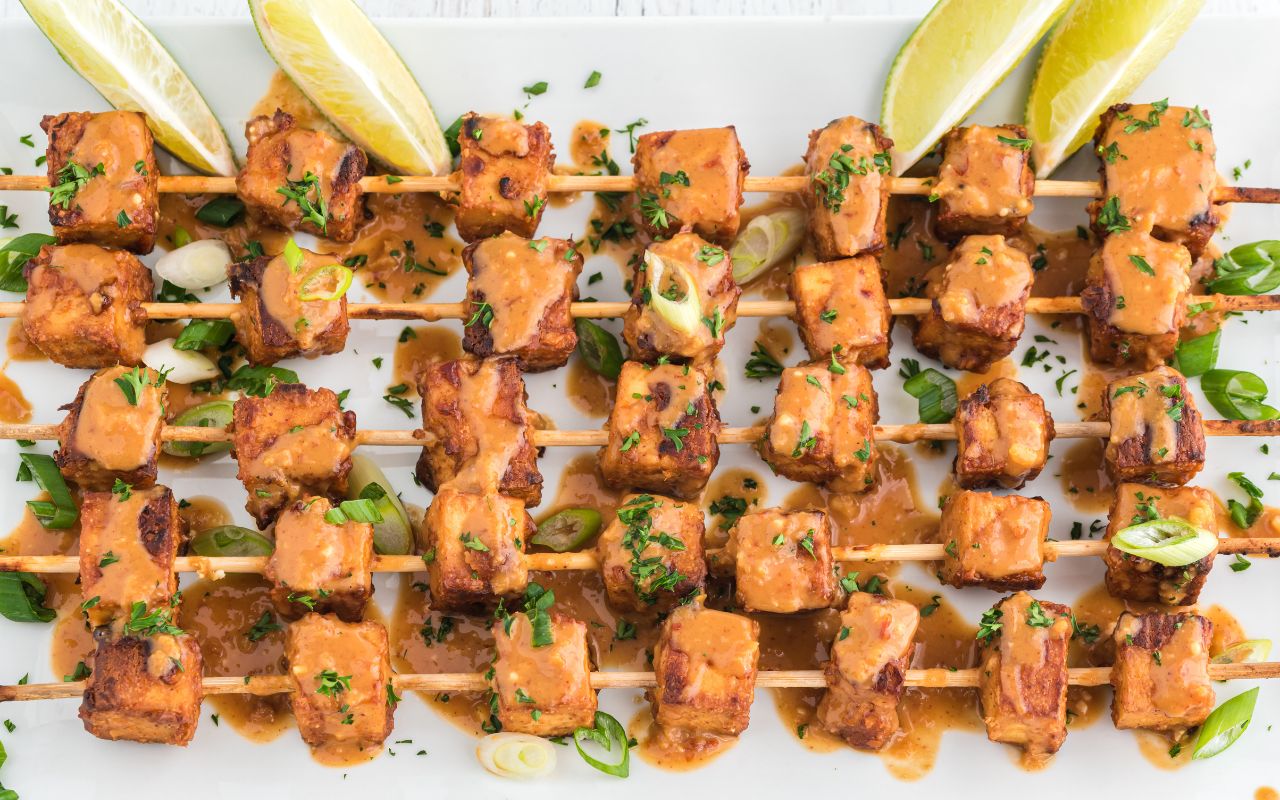
Experience the vibrant flavors of Thailand with these smoky Tempeh Satay Skewers. Organic tempeh is marinated in a flavorful mixture and then grilled to achieve a delightful smokiness. The accompanying miso peanut sauce, crafted from organic miso, organic peanut butter, organic tamari, organic rice vinegar, maple syrup, chili paste, ginger, and garlic, delivers a harmonious balance of savory and spicy notes. Garnish with zesty lime wedges, aromatic cilantro, and crisp green onions for a fresh and tantalizing finish. These skewers are easy to make for a perfect appetizer or party dish that will transport your taste buds straight to the streets of Thailand.
3. Vegan Feta and Grape Skewers
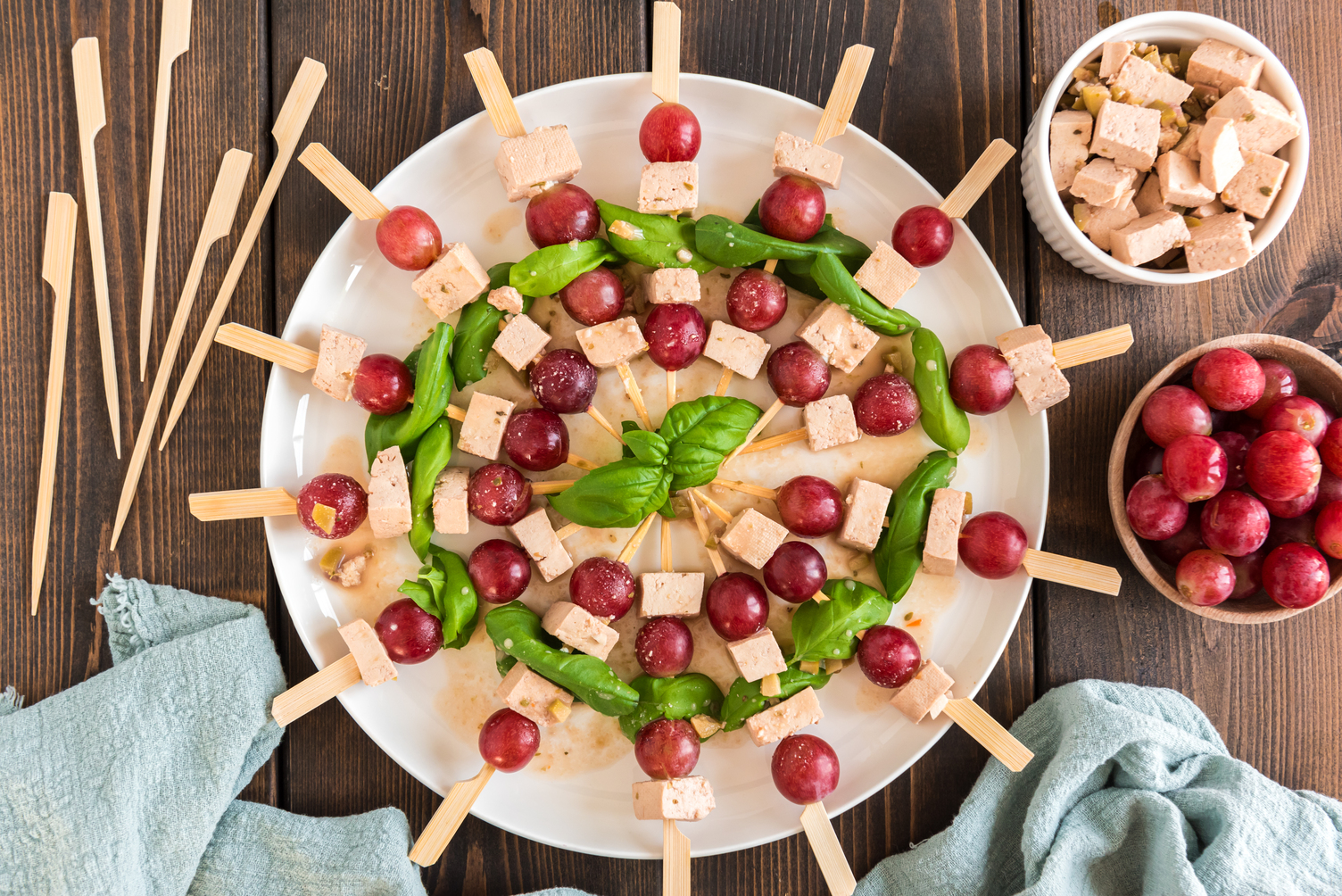
Elevate your mocktail hour with Vegan Feta and Grape Skewers, a plant-based twist on the classic party appetizer. These vibrant skewers combine the sweetness of grapes with the tanginess of vegan feta, all complemented by the fresh, aromatic notes of sweet basil. Each bite offers a perfect balance of savory and sweet, making these skewers a standout appetizer that’s sure to impress your guests!
4. Roasted Autumn Fruit and Veggie Skewers

Who says summer gets all the fun with fresh fruit and veggie skewers? Meet our Roasted Autumn Fruit and Veggie Skewers! This colorful dish combines the natural sweetness of apples, pears, and figs with the earthy richness of beets and sweet potatoes. It’s a deliciously creative way to enjoy nutrient-dense foods on a stick, perfect for adding some seasonal flair to your meals. Get ready to savor the flavors of fall in a fun and exciting way!
5. Sweet and Smoky Tofu, Vegetable, and Pineapple Skewers
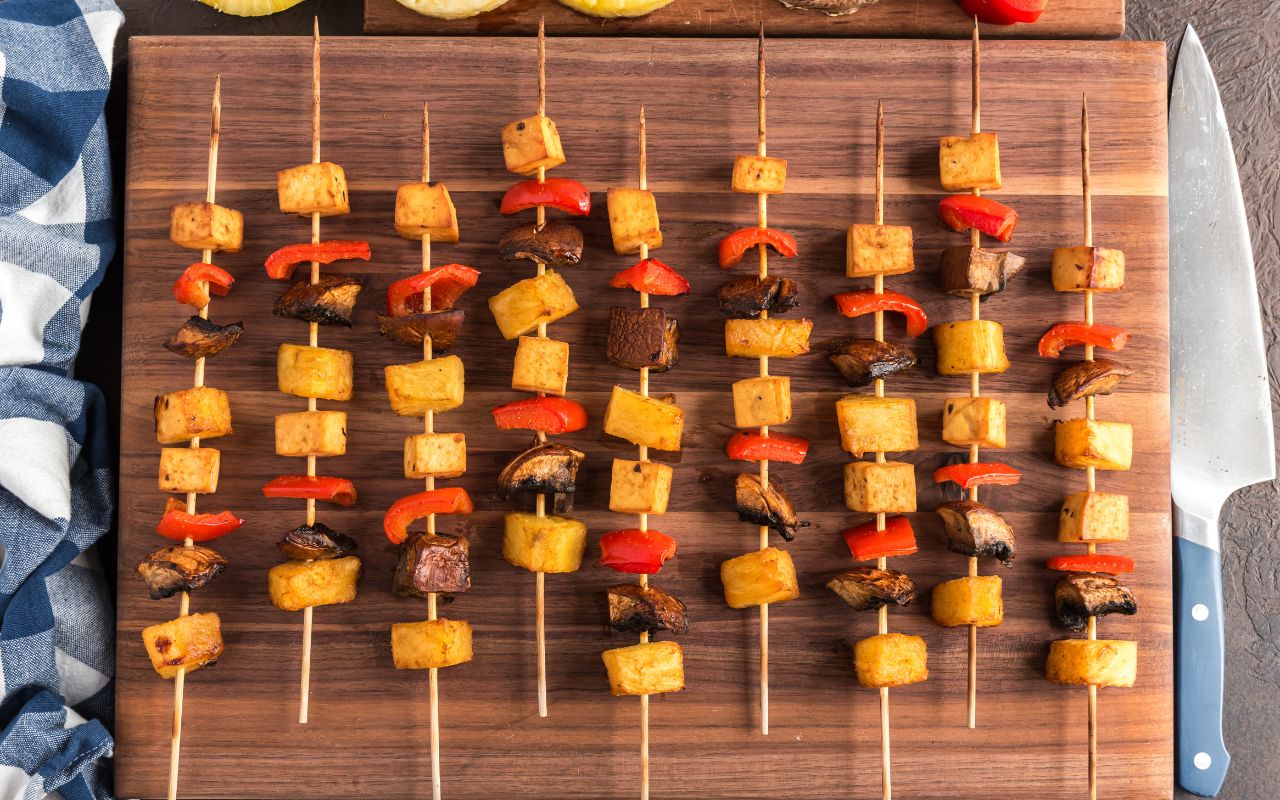
The flavors in this dish come together beautifully, especially if you let the skewers marinate for a while before baking or grilling. The umami richness of the mushrooms pairs perfectly with the sweet pineapple and savory tofu, creating a taste sensation that will delight all your taste buds. These skewers are a top choice for a plant-based recipe, earning a solid 10 out of 10!
6. Seitan Yakitori Skewers
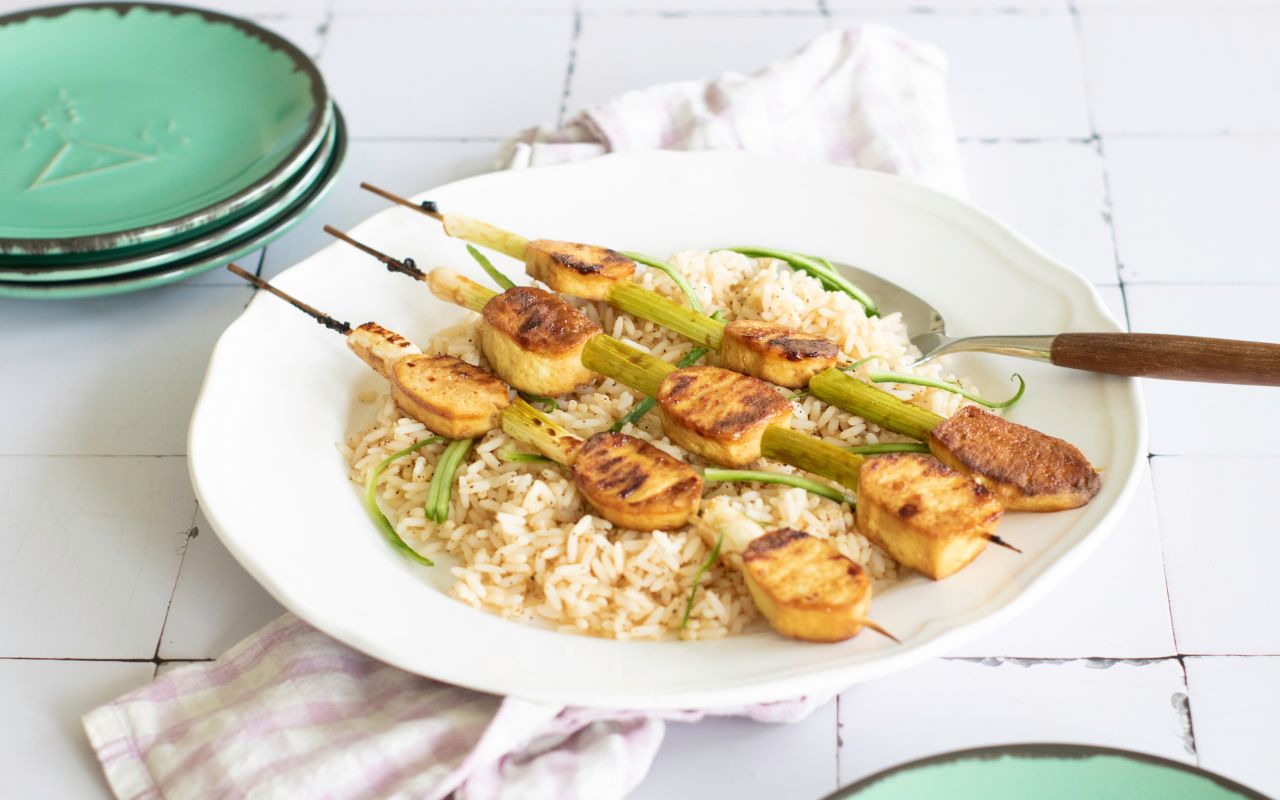
Discover the deliciousness of Seitan Yakitori Skewers, an easy and flavorful way to work with seitan if you’re new to this versatile plant-based protein. Marinated in a delectable yakitori sauce, these skewers offer a perfect balance of sweet and savory flavors. The seitan itself is prepared with a blend of organic vital wheat gluten, miso paste, garlic, onion, smoked paprika, dried thyme, and ground cumin, creating a tender and flavorful base. Roasted to perfection and garnished with fresh green onions, these skewers are not only delicious but also a great introduction to cooking with seitan. Enjoy a new culinary adventure with these tasty and easy-to-make skewers!
7. Vegan Caprese Kebabs
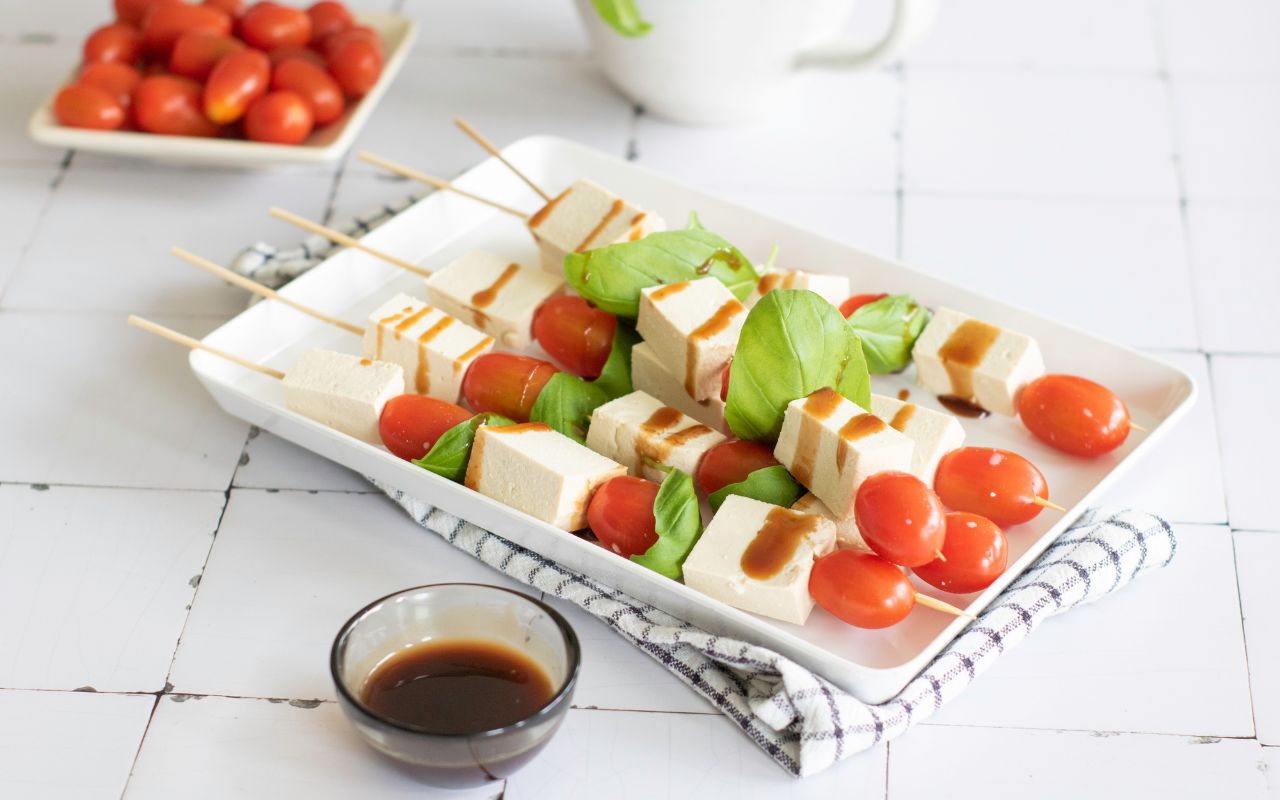
Indulge in these delightful Vegan Caprese Kebabs, featuring a simple and delicious way to make homemade vegan cheese. The creamy vegan mozzarella, made from cashews, adds a rich texture to the tomatoes and basil. Combined with organic cherry tomatoes and fresh basil leaves, these kebabs are then drizzled with a sticky balsamic glaze. The result is a mouthwatering blend of flavors, perfect for any gathering, showcasing the ease, satisfaction, and fun of presenting festive plant-based bites!
Enjoy Plant-Based Skewers and Kebabs!
You don’t need to eat meat in order to enjoy skewers and kebabs. Many plant-based foods can be combined to create delicious and craveable food on a stick. You can make vegan kebabs into versatile appetizers, sides, and meals. The recipes shared above are quick and easy to make and convenient to transport, making them perfect for parties and backyard BBQs during the summer — or whenever you want to play with your food a bit.
Tell us in the comments:
- What are your favorite plant-based kebab ingredients?
- What’s one food you’ve never thought of kebabing? (Such a useful verb!)
Featured Image: iStock.com/Nikolay_Donetsk



